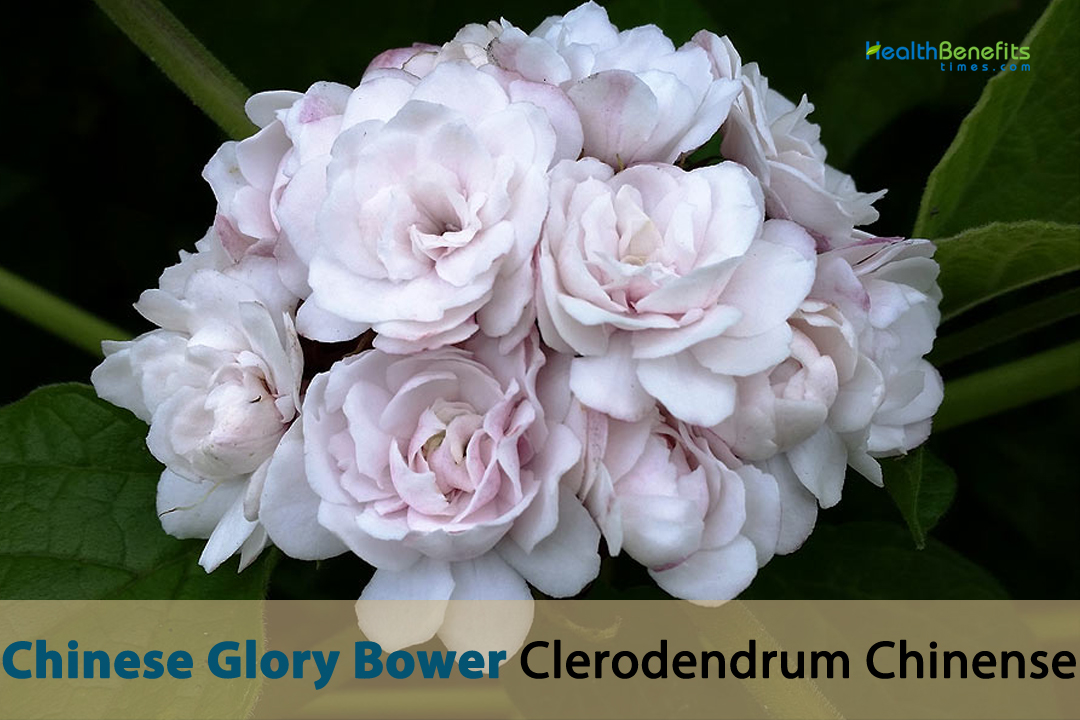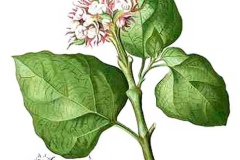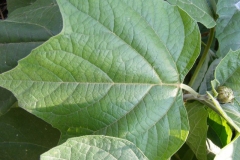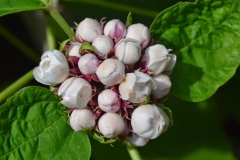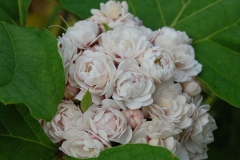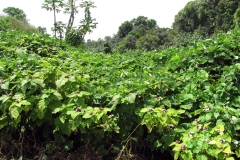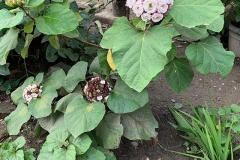Glory tree, Fragrant Cleodendron, Glory-bower, Lady Nugent’s rose, wild jasmine, Julius plague, Honolulu rose, moselle, stick shrub, rosalba, and stinking bush are some of the well-known common names for these plants. The epithet Clerodendrum is derived from the Greek words “kleros,” which signifies fortuit, and “dendron,” which refers to a tree. The species name chinensis signifies origin in China. The natural plant is harvested for medicinal purposes within the local community. It is occasionally cultivated for medicinal purposes in China and Vietnam, and is also frequently cultivated for ornamental purposes; the most prevalent cultivar is the double-flowered yet sterile variety.
Chinese Glory Bower Facts
| Chinese Glory Bower Quick Facts | |
|---|---|
| Name: | Chinese Glory Bower |
| Scientific Name: | Clerodendrum Chinense |
| Origin | Southern Asia (probably China Southeast, East Himalaya, Jawa, Lesser Sunda Is., Maluku, Myanmar, Nepal ) |
| Colors | Green to blue-black as they mature |
| Shapes | Small, fleshy fruits |
| Health benefits | Beneficial for rheumatism, asthma, inflammatory diseases, scabies, jaundice, blennorrhea, muscle pain and stiffness |
| Name | Chinese Glory Bower |
|---|---|
| Scientific Name | Clerodendrum Chinense |
| Native | Southern Asia (probably China Southeast, East Himalaya, Jawa, Lesser Sunda Is., Maluku, Myanmar, Nepal, Nicobar Is., Philippines, Sulawesi, Sumatera, Thailand and Vietnam). |
| Common Names | Stickbush, Glory-bower, Fragrant Cleodendron, fragrant glory bower, wild jasmine, Chinese glory bower, Julius plague, Lady Nugent’s rose, moselle, rosalba, stick bush, stinking bush, fragrant clerodendron, Honolulu rose, Glory tree |
| Name in Other Languages | Bahamas: Wild jasmine Chinese: Chong ban xiu mo li, Sān tái hóng huā (三台红花), Jiǔlóng tǔ zhū (九龙吐珠), Chòu mòlì (臭茉莉), Chóng bàn chòu mòlì (重瓣臭茉莉), zhòng bàn chòu mò lì, Chou mo li, Chou mu dan, Báihuā chòu mǔdān (白花臭牡丹) Cook Island: Spitate mama, tiare tupapaku Cuba: Avispero, cógelo todo, jazmín trasminador, juan grande, mil flores, mil rosas, yerba hedionda English: Stickbush, Glory-bower, Fragrant Cleodendron, fragrant glory bower, wild jasmine, Chinese glory bower, Julius plague, Lady Nugent’s rose, moselle, rosalba, stick bush, stinking bush, fragrant clerodendron, Honolulu rose, Glory tree Finnish: Tuoksukohtalonköynnös, Tuoksukohtalonpensas French: Herbe à madame villaret, caractère des homes, clérodendron de Chine German: Lauben-Losstrauch, wohlriechender Losbaum, Hawaii: Pikake hohono, Pikake pilau, Pikake wauke Indonesian: Bunga Melati Susun Papua Jamaica: Julius plague, Lady Nugent’s rose Kannada: Madras mallige (ಮದರಾಸುಮಲ್ಲಿಗೆ) Korean: Dang o dong (당오동) Lesser Antilles: Moselle, pain killer, stick-bush, wez alba Malayalam: Mottor Mohini (മോട്ടോർമോഹിനി), Ottor Mulla Manipuri: Kuthap Angouba (কুথপ অঙৌবা) Marathi: Hazari Mogra (हजारी मोगरा) Micronesia, Federated states of: Honolulu rose, rohsen onoluhlu (Pohnpei) Nepali: Banabelee (बनबेली), Raajabelee (राजबेली), Raajakalee (राजकली) Philippines: Pelegrina Pohnpeian: Rohsen onoluhlu Portuguese: Clerodendron-branco-perfumado, hortênsia-filipina Puerto Rico: Jazmín hediondo, yapaná Rai: Gandhe Chachang Samoa: Losa fiti, Losa Honolulu Sinhala: Pinna Spanish: Flor de muerto, hortensia, jazmín de muerto, jazmín de perro, jazmin hediondo, yapana, mil flores Swedish: Doftklerodendrum, Tamil: Madras Malli (மத்ராஸ மல்லீ), Mysore malligai Thai: Naang yaem (นางแย้ม), Baabg yaem, Ping son, Syan yai, USA/Hawaii: Pikake hohono, pikake pilau, pikake wauke Vietnamese: Ngọc nữ thơm, Vay trang, Mo trang, Ban trang |
| Plant Growth Habit | Erect, shrubby, branched, somewhat hairy, semi-herbaceous, evergreen, flowering shrub |
| Growing Climates | Pastures, forest edges, roadsides, waste grounds, along streams, thickets, coconut plantations, river banks, secondary forest |
| Soil | Thrive in any well-maintained, well-drained garden soil with a slightly alkaline pH |
| Plant Size | 1 to 3 meters tall |
| Root | Consist of many root suckers |
| Stem | Branches stout, finely pubescent, branchlets nearly 4-angled to round, velvet-hairy when young, becoming hairless |
| Leaf | Membranous, broadly ovate to triangular-ovate, 6-25 cm long, 5-25 cm wide, both surfaces sparsely to moderately strigillose, margins coarsely and irregularly dentate, apex acute, and base cordate to truncate |
| Flowering season | February –November |
| Flower | White to whitish pink fragrant flowers in a cyme inflorescence found in terminal positions, calyx usually purple or red and measures about 10 – 15 mm long |
| Fruit Shape & Size | Small, fleshy fruits |
| Fruit Color | Green to blue-black as they mature |
| Flavor/Aroma | Mogra like fragrance |
| Plant Parts Used | Leaves, Aerial Part, Roots, Stem |
| Propagation |
|
| Season | February–December |
Plant Description
Chinese Glory Bower is an evergreen, erect, shrubby, branched, semi-herbaceous, flowering shrub with a somewhat shaggy appearance that is renowned for its magnificent blossoms and aesthetic appeal. Globally, it is a prevalent plant in subtropical and tropical landscapes. The potential height and distribution of the Chinese Glory Bower are comparable, ranging from 1 to 2 meters, contingent upon the specific environmental conditions. Secondary forest, pastures, forest margins, roadsides, waste grounds, streams, thickets, coconut plantations, forest edges, and riverbanks are all habitats for this plant. The plant thrives in fertile, well-drained, well-maintained garden soil with a pH that is slightly alkaline. In some regions where it has been introduced, this plant may be regarded as both an aesthetic asset and an invasive species. The plant has been awarded the Award of Garden Merit by the Royal Horticultural Society.
Stem
The stems have a woody base and, as they mature, can become quite dense. Older specimens of the silky bark that covers them may begin to peel.
Leaves
The foliage consists of substantial, heart-shaped, broadly ovate leaves with a velvety texture. These plants have a typical deep green hue and can reach lengths of 6-25 centimeters and widths of 5-25 cm. Sparse to moderate strigillose covers both surfaces, while irregularly and coarsely dentate the margins, have an acute apex, and a cordate to truncate base.
Flower
The blossoms possess a pleasant aroma and are organized in terminal cyme inflorescences. The tubular shape of each flower is characterized by its five lobes, and its coloration ranges from white to pinkish or purplish at times. The calyx-tube is approximately 1.5 centimeters in length and consists of five to six lanceolate segments that are crimson-purple in color. It is slender below and enlarged above. In the tube, the white corolla measures 3 to 3.5 centimeters in diameter and 1 to 1.5 centimeters in length. Pollinators that are attracted to the blooms include bees and butterflies.
Fruit
The plant yields compact, fleshy fruits that mature from green to blue-black after flowering.
Care Chinese Glory Bower plant
- Light: Position the plant in an area that receives indirect, strong sunlight. It enjoys the sun but avoids intense midday sunlight.
- Watering: Maintain a perpetually moist yet not waterlogged soil. Once per week, or whenever the upper inch of soil becomes dry, apply water. Adjust based on the relative humidity of your residence.
- Temperature & Humidity: Ensure a warm environment (65-75°F/18-24°C is optimal). It thrives in high to moderate humidity, so misting its leaves may be advantageous.
- Fertilization: During the growing season (spring and summer), apply a balanced liquid fertilizer attenuated to half strength to your plant on a monthly basis.
- Repotting: Repot your Clerodendrum Chinense every one to two years in new, well-draining soil. Select a container that is marginally larger in order to accommodate the expansion.
Pruning
Prior to the onset of new growth in late winter or early spring, prune the plant. To shape the plant and promote bushier growth, eliminate deceased or damaged branches using clean, sharp pruning shears or loppers. Cuts should always be made at a 45-degree angle, directly above a leaf node or blossom.
Health & Safety
It is unknown whether Chinese Glory Bower is toxic or poisonous to humans, canines, or cats. However, it is consistently recommended to prevent canines from ingesting it, as is the case with any plant. It is unknown whether this plant causes contact dermatitis or other skin irritations; it is also devoid of thorns and spikes.
Pests and Problems
Chinese Glory Bower is susceptible to infestation by spider mites, aphids, and whiteflies, among others. These parasites commonly consume the plant’s sap, a process that can result in leaf wilting, impaired development, and a general deterioration of the plant’s well-being. Horticultural lubricants, insecticidal soaps, and, if required, chemical pesticides are employed as control measures. Additionally, proper air circulation around the plants is essential for preventing fungal diseases like powdery mildew.
Traditional Uses
- Roots and foliage have been utilized to treat rheumatism, asthma, and inflammatory diseases in traditional Chinese medicine.
- The Malay people apply the plant topically as a poultice to treat rheumatism and ague, or combine it with other substances to treat skin conditions.
- A decoction of leaves is employed to treat scabies in the Guianas.
- Leaves are employed in Thailand and Malaysia to treat rheumatism and ague.
- The roots are diuretic in nature.
- Acute conditions such as asthma, rheumatism, and inflammation are treated with the leaves and roots.
- A decoction of the root is employed to treat jaundice.
- Root decoction is applied topically for antiseptic purposes.
- A leaf decoction is employed as a remedy for blennorrhoea.
- The leaves have anti-blenorrheic and diuretic properties.
- It is said that decoction can be used to treat challenging cases of scabies.
- Dried roots are prepared with pork in China as a remedy for bolstering the elderly and alleviating joint and muscle pain and stiffness.
- The root and leaves of this plant are utilized in the treatment of abdominal pain, intestinal disorders, renal dysfunctions, rheumatism, asthma, and inflammatory diseases, respectively.
- This plant is utilized in Tabasco for the treatment of skin infections, in Veracruz for the control of coughs, and in Puebla for the alleviation of muscle pain.
Prevention and Control
When contemplating chemical control, it is advisable to consult the national list of registered pesticides or the relevant authority in order to ascertain which products are lawfully permitted for use in your country, given the variable regulations surrounding (de)registration of pesticides. It is imperative that pesticides be utilized in a legal and prescribed manner, as specified on the product label.
Physical/Mechanical Control
Mechanical control is challenging; persistent slitting will merely impede the spread without eradicating it. If sufficiently deep, vertical impediments in the soil may impede further spread.
Biological Control
Phyllocharis undulata, a chrysomelid beetle, exhibits promise as a bio control agent. Additional research in this field is required.
Chemical Control
The application of chemical control for C. chinense necessitates meticulous execution. As potential herbicides for Western Samoa, triclopyr butoxyethyl ester-containing herbicides are suggested. Research conducted in Western Samoa has demonstrated the efficacy of metsulfuron-methyl ester as a control agent. It has been suggested that the plants be pruned and herbicide be sprinkled on the new growth. An herbicide such as 3, 5, 6-trichloro-2-pyridinyloxyacetic acid butoxyethyl ester may be applied to young plants via spraying. Motooka et al. hypothesized that this weed could be controlled with hormone-type herbicides applied in punctual repeat applications.
Different Uses
- Ornamental Use: The ornamental value of the Chinese Glory Bower is widely acknowledged and appreciated. The aesthetically pleasing foliage and fragrant blossoms it generates have the potential to adorn both indoor and outdoor areas. Its flowers, which are typically white with a trace of pink, are recognized for attracting butterflies and bees and enhancing the garden’s biodiversity.
- Aromatherapy and Relaxation: In aromatherapy, the fragrant blossoms of the Chinese Glory Bower are occasionally employed to induce relaxation and enhance feelings of overall wellness. It is believed that the floral fragrance has a calming influence.
- Landscaping and Environmental Use: The rapid growth of the Chinese Glory Bower enables its application in landscaping as a means of erosion control, in addition to its aesthetic appeal. Its ability to rapidly cover barren areas aids in soil stabilization and erosion prevention.
- Cultural and Spiritual Significance: Spiritual or symbolic in nature, the Chinese Glory Bower is utilized in religious and cultural ceremonies in some cultures.
References:
https://www.cabidigitallibrary.org/doi/10.1079/cabicompendium.113371
https://gd.eppo.int/taxon/CLZFR
http://www.stuartxchange.com/Pelegrina.html
https://plants.sc.egov.usda.gov/home/plantProfile?symbol=CLCH4
https://en.wikipedia.org/wiki/Clerodendrum_chinense
https://indiabiodiversity.org/species/show/229226
https://www.flowersofindia.net/catalog/slides/Chinese%20Glory%20Bower.html
https://apg.pir.sa.gov.au/gringlobal/taxon/taxonomydetail?id=407664
https://tropical.theferns.info/viewtropical.php?id=Clerodendrum+chinense


